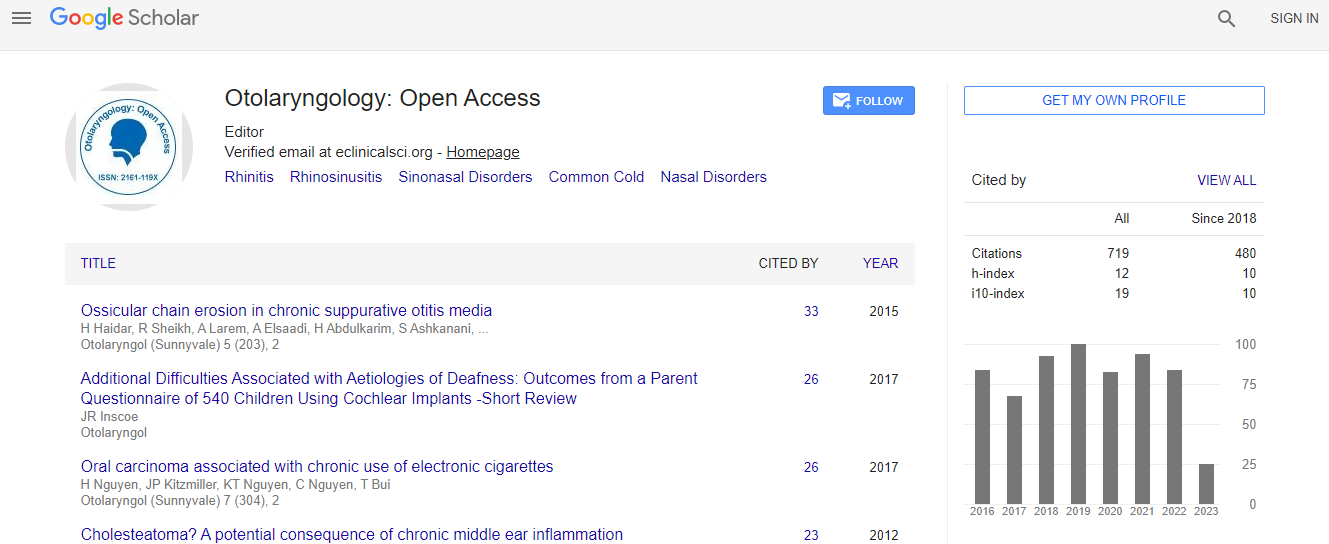Our Group organises 3000+ Global Conferenceseries Events every year across USA, Europe & Asia with support from 1000 more scientific Societies and Publishes 700+ Open Access Journals which contains over 50000 eminent personalities, reputed scientists as editorial board members.
Open Access Journals gaining more Readers and Citations
700 Journals and 15,000,000 Readers Each Journal is getting 25,000+ Readers
Google Scholar citation report
Citations : 925
Otolaryngology: Open Access received 925 citations as per Google Scholar report
Otolaryngology: Open Access peer review process verified at publons
Indexed In
- Index Copernicus
- Google Scholar
- Sherpa Romeo
- Open J Gate
- Genamics JournalSeek
- RefSeek
- Hamdard University
- EBSCO A-Z
- OCLC- WorldCat
- Publons
- Geneva Foundation for Medical Education and Research
- ICMJE
Useful Links
Recommended Journals
Related Subjects
Share This Page
Impact of UPPP on CPAP levels in patients OSAS
3rd International Conference and Exhibition on Rhinology & Otology
Vural Fidan
Yunus Emre Government Hospital, Turkey
Posters & Accepted Abstracts: Otolaryngology
Abstract
Objectives: Obstructive Sleep Apnea Syndrome (OSAS) is associated with severe complications. Uvulopalatopharyngoplasty (UPPP) is one of several treatment modalities suggested for OSAS. The purpose of this study is to evaluate the effect of UPPP on Nasal Continuous Positive Airway Pressure (CPAP) levels in patients with OSAS. Methods: 20 patients who had been diagnosed with OSAS before UPPP were retrospectively evaluated. All patients had demonstrated compliance on home CPAP therapy, were minimally 6 months post-surgery and had follow-up reports that their CPAP was less effective. We collected data on age, sex, weight, BMI and apnea/hypopnea index (AHI). Optimal CPAP pressure was determined initially through attended in laboratory complex polysomnography. Follow-up CPAP pressure was obtained using an auto-titrating PAP device at home. These data were used to appreciate the pressure alterations that accompanied surgery. Results: The starting CPAP pressures averaged 12�±3.5 cm H2O with a range of 8-18 cm H2O. Follow-up CPAP pressures averaged 9.5�±2.9 cm H2O with a range of 4-12 cm H2O, representing an overall reduction of 22%. Conclusion: CPAP pressure requirements shift considerably in patients undergoing UPPP. Auto-titrating PAP devices have commit for facilitating the management of CPAP therapy during this time. Consideration should also be given to the use of auto titrating PAP units as the treatment of choice in these subjects.Biography
Email: vuralf@mynet.com

 Spanish
Spanish  Chinese
Chinese  Russian
Russian  German
German  French
French  Japanese
Japanese  Portuguese
Portuguese  Hindi
Hindi 
